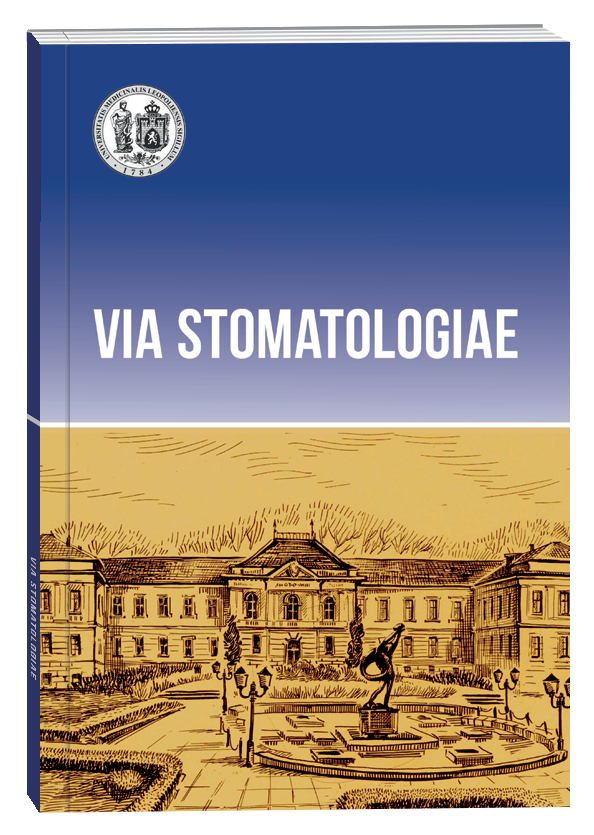THE RESULTS OF THE STUDY OF INSTRUMENTAL PARAMETERS OF THE STABILITY OF DENTAL IMPLANTS AT THE SURGICAL AND PROSTHETIC STAGES OF PATIENT’S DENTAL TREATMENT
DOI:
https://doi.org/10.32782/3041-1394.2024-3.3Keywords:
dental implants, biomechanical and biological stability of implants in bone tissue, functional load of implants, resonance-frequency analysis of dental implantsAbstract
The stability of implant positioning in the tissue surrounding the jaws is an important factor influencing the planning of the methodology for placement and loading of dental implants (DI). According to literature sources and practical recommendations, it is considered that initial mechanical stability and the absence of any undesirable micro-movements upon achieving biological stability are important morphological conditions necessary for adequate preparation of DI for functional loading during prosthetic rehabilitation. The assessment of current methods for measuring DI stability clearly demonstrates the need for a non-invasive, quantitative, repeatable, and reliable method of measurement. As early as 1996 [12], first reported the possibilities of using a Resonance Frequency Analyzer (RFA) to assess DI stability by determining the frequency of vibration signals repeatedly directed at the sensor surface inserted into the DI. The stronger the union of the DI with the bone surfaces, the resonance occurs at a higher frequency. By employing this innovative digital method, we conducted a three-year study and analysis of RFA data on DI stability in patients with tooth arch defects. Instrumental RFA measurements were performed using the Osstell digital device in ISQ units during placement and prior to functional loading of prosthetic constructions on DI in the early healing period within 2–4 months and delayed loading – after 4–6 months. Statistical analysis of the interquartile optimum indicator of obtained digital RFA values was used to determine the success of DI at the stages of early and delayed prosthetic rehabilitation compared to baseline data after DI insertion. Based on the analysis of the obtained RFA data during implantation, it was found that the smaller the interquartile range of ISQ stability indicators of DI at surgical and orthopedic stages of implant treatment in patients, the more favorable the combination of primary and secondary DI stability, which will lead to better osseointegration.
References
Результати клінічно–інструментального визначення стабільності імплантатів у кістковій тканині альвеолярних відростків щелеп / В.Ю. Вовк та ін. Новини стоматології. 2014. № 1 (78). С. 66–72.
Вовк Ю.В., Вовк В.Ю. Експериментальне дослідження стану кісткової тканини при впливі тривалого функціонального навантаження на дентальні імплантати, уведені з різностороннім нахилом. Новини стоматології. 2017. № 2 (37). С. 28–36.
Вовк Ю.В., Вовк В.Ю. Експериментальне дослідження впливу тривалого функціонального навантаження дентальних імплантатів, уведених в осьовому та параосьовому положеннях на стан периімплантної кісткової тканини. Матеріали V з’їзду української асоціації черепно-щелепно-лицевих хірургів. Київ, 2017. С. 181–184.
Вовк В.Ю., Вовк Ю.В. Застосування комплексного хірургічно-ортопедичного стоматологічного підходу в діагностиці та лікуванні хворих з дефектами альвеолярних відростків щелеп при порушенні фізіологічних міжщелепових співвідношень. Сучасна стоматологія та щелепно-лицева хірургія : матеріали Науково-практичної конференції. Київ, 2020. С. 111.
Вовк В.Ю., Вовк Ю.В. Клінічно-інструментальний аналіз впливу функціонально направленого встановлення дентальних імплантатів та протезних конструкцій у пацієнтів з дисфункцією стоматогнатичної системи. Сучасна стоматологія та щелепно-лицева хірургія. До 30-річчя співпраці EACMFS з UACMFS і першого візиту президента EACMFS Р. Фріса в Україну : матеріали Науково-практичної конференції. Київ, 2022. С. 163–164.
Osseointegrated implants in the treatment of the edentulous jaw. Experience from a 10-year period / P.I. Brånemark et al. Scand J Plast Reconstr Surg Suppl. 1977. № 16 (1). P. 132.
De novo alveolar bone formation adjacent to endosseous implants / T. Berglundh et al. Clin. Oral Implants Res. 2003. № 14 (3). P. 251–62.
Early osseointegration to hydrophilic and hydrophobic implant surfaces in humans / N.P. Lang et al. Clin. Oral Implants Res. 2011. № 22 (2). P. 349–356.
Interventions for replacing missing teeth: different times for loading dental implants / M. Esposito et al. Cochrane Data-base Syst. Rev. 2007. № 2. CD003878.
Consensus statements and recommended clinical procedures regarding loading protocols / H.P. Weber et al. Int J Oral Maxillofac Implants. 2009. 24 (Suppl). P. 180–183.
Resonance frequency analysis: comparing two clinical instruments / W. Becker et al. Clin. Implant. Dent. Relat. Res. 2018. № 20 (2). P. 308–312.
Meredith N. Assessmen of implant stability as a prognostic determinant. Int J. Prosthodont. 1998. № 11 (3). P. 491–501.
Arandomized controlled clinical trial comparing the effects of three loading protocols on dental implant stability / R.M. Barewal et al. Int. J. Oral Maxillofac. Implants. 2012. № 27 (5). P. 945–956.
A resonance frequency analysis assessment of maxillary and mandibular immediately loaded implants / S.F. Balshi et al. Int J Oral Maxillofac Implants. 2005. № 20 (3). P. 584–954.
Sennerby L., Meredith N. Implant stability measurements using resonance frequency analysis: biological and biomechanical aspects and clinical implications. Periodontology. 2000. № 47 (1). P. 51–66.
Early Loading of Nonsubmerged Titanium Implants with a Chemically Modified Sand-Blasted and Acid-Etched Surface: 6-Month Results of a Prospective Case Series Study in the Posterior Mandible Focusing on Peri-Implant Crestal Bone Changes and Implant Stability Quotient (ISQ) Values / M.M. Bornstein et al. Clinical Implant Dentistry and Related Research. 2009. № 48 (1). P. 1–10.
Buser D. How to use Osstell ISQ values to shorten implant healing periods in daily practice : Osstell company Webinar, participants Certificate Y. Vovk, V. Vovk. 2020.







